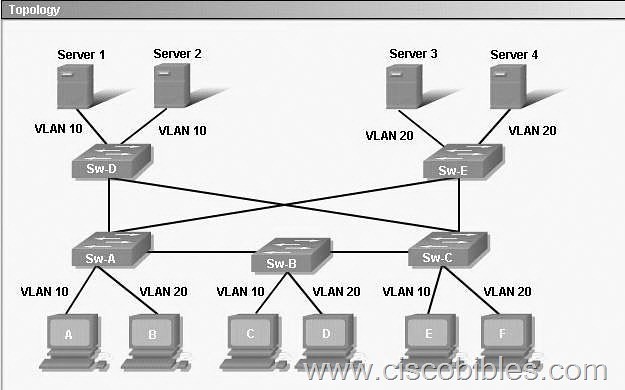This item contains several questions that you must answer. You can view these questions by clicking on the corresponding button to the left Changing questions can be accomplished by clicking the numbers to the left of each question. In order to complete the questions, you will need to refer to the topology.
To gain access to the topology, click on the topology button at the bottom of the screen. When you have finished viewing the topology, you can return to your questions by clicking on the Questions button tothe left.
Each of the windows can be minimized by clicking on the [-]. You can also reposition a window by dragging it by the title bar.
Refer to the topology. Using the information shown, answer the five questions shown on the Questions tab.

Question 1:
If most of the communication is between hosts and the servers, which switch is best as the root switch for VLAN 20?
A – Sw-A
B – Sw-B
C – Sw-C
D – Sw-D
E – Sw-E
Answer: E
Explanation:
Server 3 and Server 4 belong to VLAN 20 and are connected to Switch-E. If the question asks which switch is best for the whole network then the answer should be Switch-B because it is the most centralized switch on the network.
Question 2:
If Sw-E is the root for all VLANs, which of the following is a valid path from host A to Server 1?
A – Sw-A, Sw-D
B – Sw-A, Sw-E, Sw-D
C – Sw-A, Sw-B, Sw-C, Sw-D
D – Sw-A, Sw-E, Sw-C, Sw-D
E – Sw-A, Sw-E, Sw-A, Svv-D
Answer: D
Explanation:
All the traffic must go through root switch so the shortest path should be Sw-A -> Sw-E -> Sw-C -> Sw-D (notice that traffic can not go through Sw-A -> Sw-E and back to Sw-A again)
Question 3:
What technology helps prevent frames from looping continuously through this switched network?
A – ARP
B – VTP
C – STP
D – EIGRP
E – CSMA/CD
Answer: C
Question 4:
What, if anything, is required for communication to occur between the host C and Server 3?
A – DHCP
B – a router
C – nothing is required
D – trunk link between Sw-B and Sw-E
Answer: B
Explanation:
Since host C (VLAN 10) and Server 3 (VLAN 20) belong to different VLANs so we need a Layer 3 device (like a router) for inter-VLAN communication.
Question 5:
What type of link is needed between Sw-A and Sw-B so host C and host D can communicate through Sw-A to the servers?
A – trunk
B – access
C – multi-access
D – straight-through
Answer: A
Explanation:
Communication between different VLANs requires a trunk link to forward traffic normally.




